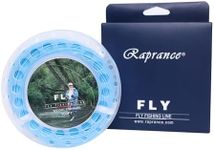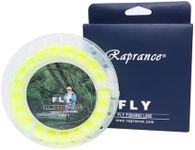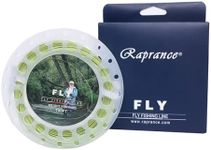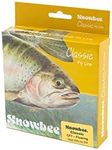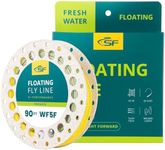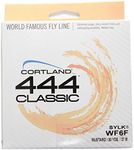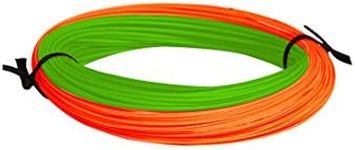Buying Guide for the Best Floating Fly Line
Choosing the right floating fly line is crucial for a successful fly fishing experience. The floating fly line is designed to stay on the surface of the water, making it ideal for fishing with dry flies, nymphs, and other surface presentations. To make an informed decision, you need to understand the key specifications and how they relate to your fishing needs and preferences.Line WeightLine weight refers to the thickness and heaviness of the fly line, which is measured in a numerical system (e.g., 3-weight, 5-weight, 8-weight). This spec is important because it determines the type of fish you can target and the size of the flies you can cast. Lighter lines (1-3 weight) are suitable for small fish and delicate presentations, while medium lines (4-6 weight) are versatile for trout and bass fishing. Heavier lines (7-9 weight) are used for larger fish and bigger flies. Choose a line weight that matches your rod and the type of fishing you plan to do.
Taper DesignTaper design refers to the shape and distribution of weight along the length of the fly line. This affects casting performance and presentation. There are several types of tapers, including weight-forward, double-taper, and specialty tapers. Weight-forward tapers are the most common and are great for long casts and windy conditions. Double-taper lines offer delicate presentations and are ideal for short to medium casts. Specialty tapers are designed for specific fishing situations, such as bass or saltwater fishing. Consider the type of fishing you do most often and choose a taper that enhances your casting and presentation.
Line LengthLine length is the total length of the fly line, typically ranging from 80 to 120 feet. This spec is important because it affects your casting distance and ability to reach fish. Standard lengths (90-100 feet) are suitable for most fishing situations, providing a good balance between casting distance and control. Longer lines (100+ feet) are useful for large bodies of water where long casts are necessary. Shorter lines (80-90 feet) are easier to manage and ideal for small streams and tight spaces. Choose a line length based on the size of the water you fish and your casting ability.
Core MaterialCore material refers to the inner structure of the fly line, which affects its strength, flexibility, and sensitivity. Common core materials include braided nylon, monofilament, and gel-spun polyethylene. Braided nylon cores offer a good balance of strength and flexibility, making them suitable for most fishing situations. Monofilament cores provide extra sensitivity and are great for detecting subtle bites. Gel-spun polyethylene cores are extremely strong and durable, ideal for targeting large, powerful fish. Consider the type of fish you target and the conditions you fish in when choosing a core material.
CoatingCoating refers to the outer layer of the fly line, which affects its floatability, durability, and casting performance. Common coatings include PVC, polyurethane, and silicone. PVC coatings are durable and provide good floatability, making them suitable for most fishing conditions. Polyurethane coatings offer excellent casting performance and are resistant to cracking in cold weather. Silicone coatings provide superior floatability and are ideal for dry fly fishing. Choose a coating based on your fishing environment and the type of presentation you need.
